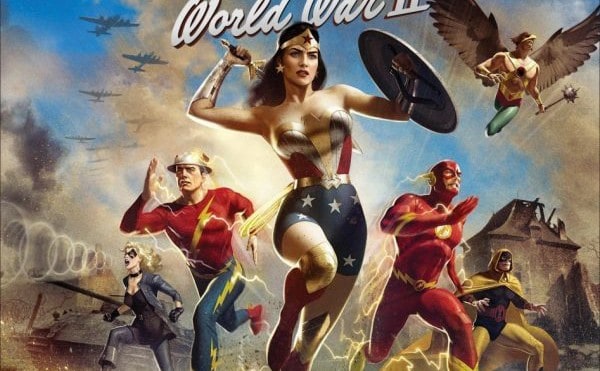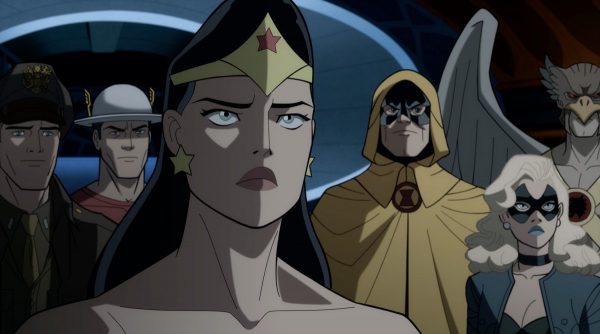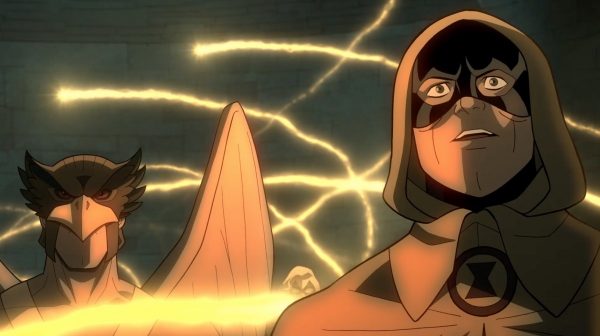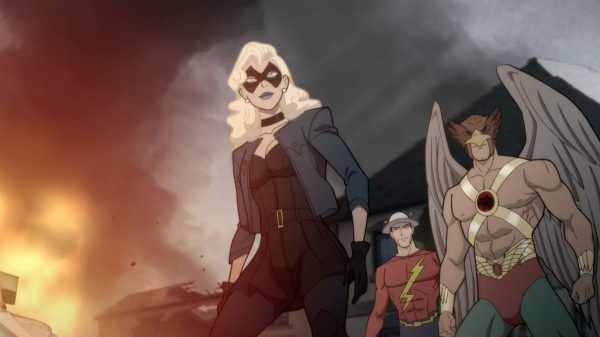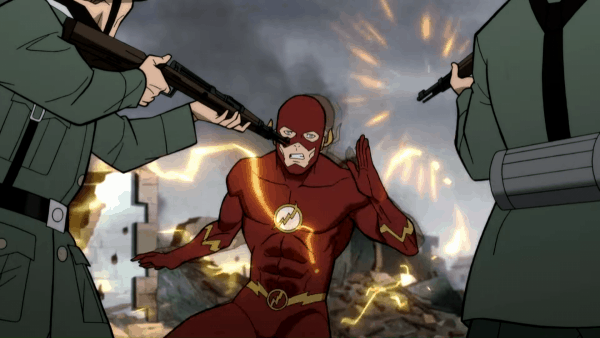Ricky Church chats with Justice Society: World War II co-writer Meghan Fitzmartin…
Though the Justice League consists of some of the most popular superheroes in comics and has been around for decades, they are not the first superhero team in either the DC Universe or the comic book industry. In 1940 the world was introduced to the Justice Society of America, a group of heroes made up of those with superpowers, scientists or highly skilled people who went on adventures, fought supervillains and even took part in World War II, fighting for the Allies against Nazi Germany and members of the Axis.
The original line-up included characters like Jay Garrick and Alan Scott, the original Flash and Green Lantern respectively, Hourman, Doctor Fate and Hawkman with Wonder Woman and Black Canary being added to the team later. While the Justice Society may not be as popular as the Justice League now, the JSA was a pretty big title for several years after its creation and remains a favourite among fans, so much so when DC wiped away the JSA out of continuity in their 2011 reboot many fans cried foul.
In a few weeks the Justice Society will receive their first feature length animated adventure Justice Society: World War II, the latest film in DC’s line of original animated movies. It follows Barry Allen’s Flash as he accidentally travels back in time, landing in Nazi-occupied France and meets the Justice Society, a team of secret superheroes led by Wonder Woman. Flash teams up with them to uncover the Nazis’ latest scheme and find a way to travel back to his time. We got to chat with the co-writer of the film Meghan Fitzmartin, whose previous work includes Supernatural, DC Superhero Girls and DC’s Future State comic Robin Eternal. Our interview features Fitzmartin’s thoughts on the Justice Society’s popularity, placing the film in WWII era rather than modern day, how they chose the team line-up and more. Check out our interview below…
Ricky Church: The Justice Society has some of the oldest characters in comics from the first generation of the Golden Age. What was the appeal of adapting these characters for you?
Meghan Fitzmartin: I think part of the appeal is the fact that we have not seen a lot of these characters before. Some we have, like we’ve seen versions of Hawkman, we’ve seen versions of Black Canary, but Hourman is a character I was super excited to write because we just don’t really see a lot of him. There’s a lot from that particular time period that we don’t get. I was thrilled to be able to play around.
The JSA of the movie consists of some original members and some other characters who were added later, such as Wonder Woman and Black Canary. How did you guys choose the team’s lineup?
So we sat at one of the offices at DC Animation and we went through it. I liken it to holding up pictures of everybody in classic JSA and whatever it is that people think of JSA and sort of talking through what do they bring to the story? What did they take away from it? In a movie like this you can’t have everybody as much as you want to and so having those conversations was like ‘Why do we choose this character? Why do we not choose another character?’ Making sure that we are making as well-informed choices as we can to make the best story that we can. I love the team that we have. I love them very much so.
You co-wrote this movie with Jeremy Adams. How did you two work together? What did he bring to the table that helped you?
So Jeremy is very much the romantic and the one who’s like “What about these really schmaltzy moments?” So like characters gaze longingly at each other’s eyes, which is great. And then I’m like “What if this character is sad? What can we do to make them sad as possible?” It was a really lovely balance because I would come in and be like what if they’re said and he’s like “We can’t, they were already sad last scene, we need to pull it back” and he’d be like “We’re going to be schmaltzy!” And I’m like okay because I wouldn’t have thought of this, but maybe not as schmaltzy. I think ultimately we balanced off each other very nicely.
Nice! Now, this isn’t your first time writing for anything DC related because some of your past work includes the DC Superhero Girls show. How do you bounce from writing a show which is very fun and aimed at a younger audience to something so dramatic and heavy as the Justice Society in World War II?
So much for bouncing between mediums to me is very much about character and doing the character work and figuring out where the characters are emotionally. DC Superhero Girls was a different emotional space than the characters in Justice Society. I think that honestly helped me tell each story and balance between mediums in a way because I knew walking into each space, especially with characters that I’ve grown up with, I knew where they were going to be at emotionally and I could write towards it. It didn’t matter if it was more serious or more playful because ultimately I was getting at the core of the heart of the characters.
For sure. Do you have a favourite member of the JSA? If so, who and why?
I mean, they’re all my children and I love them very much! How dare you ask me to choose! I think that I like all of them for different reasons. The two that I think surprised me most was, like Wonder Woman I knew, I knew I would love writing for Wonder Woman. She’s amazing and such an inspiration for me because I’m also like “Oh yeah, well if Diana can do it, I can do it!” This is not true. I can’t like, I can’t fight people like she can. Like it’s still possible, but it’s the same sort of emotion or the same sort of inspiration. But the two I was most surprised by and ended up getting really psyched about was Hourman because we don’t normally see Hourman and I was really thrilled to play with that character. And also Black Canary! I love Black Canary. I had a thought that I would because I grew up reading Birds of Prey and she’s very cool in that, but getting to meet her in this space was so exciting. It was different than I had expected so I loved that.
Yeah, for sure. I really enjoyed Black Canary in this movie as well. I thought she was great which actually leads me into my next question. The film is really well animated and some of my favourite moments are the displays of Wonder Woman, Flash and Black Canary’s power. Were those sequences where they’re showing off their power difficult to write and how do you feel seeing it brought to life?
I mean, seeing it on the big screen was such a good example of why I love working in a collaborative medium. Whenever I write things, I have a vague sense of how it can be turned out, but I never truly know because that’s the fun of seeing how animators work and seeing what they bring to the table and seeing also the emotion that the actors bring to the table too. It is always so wonderful and exciting! Mine is only a part of the work and then whenever you see the final product it’s like ‘Wow, everybody came together so well in making this film’ and doing these fight scenes that were really fun to write. It’s really fun to write ‘and then Wonder Woman kicks some Nazi ass!’ Like, that’s one of the best thing you ever get to write. But then seeing the animators and hearing how Stana [Katic, voice of Wonder Woman] killed it, it’s such a good example of like I know we’re all in this together. We’re all making something really cool. I love collaborating in that way. I love building things with other people. It’s a joy.
Now obviously war, especially one like a World War II, is a sensitive and heavy topic. How did you balance the seriousness of the drama with the super hero spectacle?
I think part of it, I think it goes back to the answer I had earlier about character. I think that that’s sort of what helped me and Jeremy most is when we would get into serious circumstances, we would think how’s everybody reacting here, like having an emotional touch base on like ‘Hey, how you doing?’ and that really lightened it up. We were able to sort of touch base with everybody and it created this sense of a really filling out the world because we get to see how the people feel about war and how they’re reacting to it. Sometimes it’s grim and sometimes you react out of humor. Those are all, I feel, incredibly human reactions. I think that just following the lead of the characters was extremely helpful in balancing that.
You’re also currently writing a Future State comic starring Robin called Robin Eternal. What’s the difference for you between writing comics and animation? Is there anything you can tease about that title?
Well, nothing I can really tease, but I think the difference is comics is so static. You have to think very seriously about, okay, what image do I want to make sure everybody sees? That is very similar to animation because in both animation and comics, you are telling the animator or the artists “Hey, I need to see this thing” which is really great and interesting. In animation we get to go through the transition period whereas in comics you don’t. That’s a super technical answer that I’m sure you weren’t looking for, but that is unfortunately the answer that I have for you!
Thank you very much to Meghan Fitzmartin for speaking with us!
SEE ALSO: Exclusive Interview: Justice Society: World War II co-writer Jeremy Adams
Justice Society: World War II will be released on digital April 27th and Blu-ray May 11th.
Ricky Church – Follow me on Twitter for more movie news and nerd talk.
